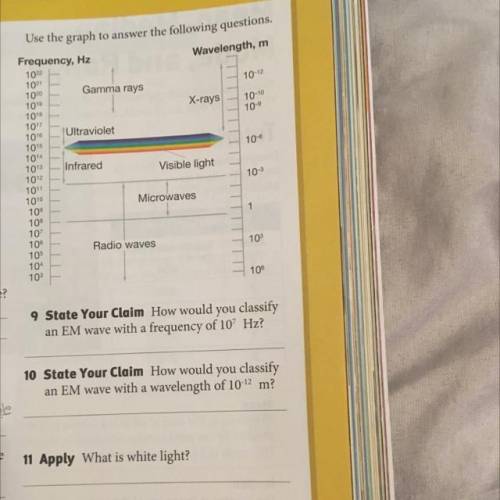Use the graph to answer the following questions.
Frequency. Hz
Wavelength, m
10
1...

Physics, 19.11.2020 07:00, shekinahconnoll3904
Use the graph to answer the following questions.
Frequency. Hz
Wavelength, m
10
10
Gamma rays
X-rays
10
10
TO
10
TO
10
Ultraviolet
10-
Infrared
Visible light
10
Microwaves
10
10
10
10
10
10
10
10
TOP
10
10
10
10
10
Radio waves
10
T
10
9 State Your Claim How would you classify
an EM wave with a frequency of 10' Hz?
10 State Your Claim How would you classify
an EM wave with a wavelength of 10 m?
11 Apply What is white light?


Answers: 1
Other questions on the subject: Physics

Physics, 21.06.2019 22:00, jby
Atank holds 1000 gallons of water, which drains from the bottom of the tank in half an hour. the values in the table show the volume v of water remaining in the tank (in gallons) after t minutes. t(min) 5 10 15 20 25 30v(gal) 694 444 250 111 28 0(a) if p is the point (15, 250) on the graph of v, find the slopes of the secant lines pq when q is the point on the graph with t = 5, 10, 20, 25, and 30.(b) estimate the slope of the tangent line at p by averaging the slopes of two secant lines.(c) use a graph of the function to estimate the slope of the tangent line at p. (this slope represents the rate at which the water is flowing from the tank after 15 minutes.)show all steps.
Answers: 2

Physics, 22.06.2019 00:10, oktacos
The energy released by a chemical reaction can be measured using a calorimeter. when barium hydroxide octahydrate crystals are reacted with dry ammonium chloride inside of a coffee cup calorimeter, the temperature of the 18.00 g of water in the calorimeter decreases from 30.0°c to 8.0°c. the equation for calculating energy absorbed or released by a reaction is: where q is the energy released or absorbed, m is the mass of water in the calorimeter, cp is the specific heat of water, and δt is the observed temperature change. if the specific heat of liquid water is 4.19 j/g·°c, how much energy was absorbed by the reaction?
Answers: 3

Physics, 22.06.2019 03:00, lananamr
Dinate system, and a charge q = - 2.00 nc is placed s2 10 n> c. (a) what is the change in electric potential energy when the dipole moment of a molecule changes its orientation with respect to es from parallel to perpendicular? (b) at what absolute temperature t is the average translational kinetic energy 32 kt of a molecule equal to the change in potential energy calculated in part(: abovethistemperature, thermalagitationprevents the dipoles from aligning with the electric field.) placed in a uniform electric field e with magnitude 1.6 * 6 on the positive x-axis at x = 4.00 cm. (a) if a third charge q3 = +6.00 nc is now placed at the point x = 4.00 cm, y = 3.00 cm, find the x- and y-components of the total force exerted on this charge by the other two. (b) find the magnitude and direction of figure p21.62 ll uu 21.55 . torque on a dipole. an electric dipole with dipole moment ps is in a uniform external electric field es. (a) find the orientations of the dipole for which the torque on the dipole is zero. (b) which of the orientations in part (a) is stable, and which is unstable? (hint: consider a small rotation away from the equi- librium position and see what happens.) (c) show that for the stable orientation in part (b), the dipole’s own electric field tends to oppose the external field. 21.62 ..
Answers: 1
Do you know the correct answer?
Questions in other subjects:

Spanish, 18.03.2021 18:30



Mathematics, 18.03.2021 18:30


Computers and Technology, 18.03.2021 18:30

Mathematics, 18.03.2021 18:30

Mathematics, 18.03.2021 18:30


Mathematics, 18.03.2021 18:30






